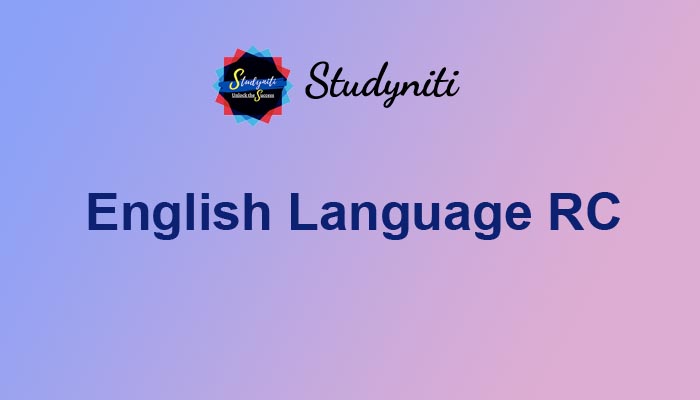
English Language RC
Oct 21 2020
Here we are providing new series of English Language Questions for upcoming exams, so the aspirants can practice it on a daily basis.
Read the following passage carefully and answer the questions given below the passage.
India’s poor progress on nutritional indices must dispel the hubris surrounding strong economic growth for years, and turn national focus on persisting hunger, wasting and stunting among children. This year’s Global Hunger Index (GHI) places India in the company of Sudan — rank 94 among 107 countries — with the unedifying assessment of the national situation as “serious”. The country’s score of 27.2 is the worst among BRICS countries, and inferior to Pakistan, Sri Lanka, Bangladesh and Nepal. The GHI is developed around wasting and stunting (under five), the share of the population with insufficient caloric intake, and child mortality. Index scores by international agencies have been critiqued as flawed for choosing the wrong weights in scoring, and also for not including genetics and social determinants, but that would be a narrow view. The evidence from the NFHS-4 of 2015-16 is not very different. The reality is that national policy has no appetite for a radical transformation in the delivery of adequate nutrition especially to women and children, and has paid inadequate attention to achieving diet diversity through the PDS. On the other hand, the country is widely seen as falsely equating energy calories with a diverse diet. The existing deprivation has been aggravated by the pandemic, with food inflation putting pressure on depleted incomes or meagre pensions and savings.
The NFHS-4 found that under-five stunting from chronic undernourishment stood at 38%, and wasting, a result of acute lack of nutrition, at 21%. These data represent some progress, at a drop of about 10 percentage points in both categories compared to a decade earlier, although steady economic prosperity should have yielded a far bigger social dividend. The latest GHI measure is a reminder that much work is necessary to bring the true benefits of the National Food Security Act to the unreached, not merely as hunger mitigation through cereals, but as nourishment through a diverse diet that includes fat, protein and micronutrients. But there are worrying indications that the Centre has chosen the wrong course. In its pursuit of fraud within the PDS, it is inclined to take hard measures that would deprive the disabled and the elderly of even cereals, by insisting on biometric verification to get supplies. Strengthening the PDS, with a focus on women’s health, would lead to healthier pregnancies, and stronger supplemental nutrition under the ICDS scheme would give children a better chance at all-round development. The importance of sustained, immediate intervention is further underscored by recent findings of International Food Policy Research Institute scholars that three out of four rural Indians cannot afford a balanced, nutritious diet. The right to food would be meaningless if it leaves a large section of Indians hungry, stunted and wasted.
1) What did The NFHS-4 found according to the passage?
a)under-five stunting from chronic undernourishment stood at 38%,
b)wasting, a result of acute lack of nutrition, stood at 21%
c)wasting, a result of acute lack of nutrition, stood at 20%
d) Both (a) and (b)
e) Both (a) and (c)
2) What would give children a better chance at all-round development?
a)stronger supplemental nutrition under the Atmanirbhar Bharat Scheme
b)a focus on women’s health
c)stronger supplemental nutrition under the ICDS scheme
d) Vaccines
e) None of these
3) Find a suitable title for the passage.
a)No great escape: On India’s low rank on nutritional indices
b) Migrant workers and their joblessness after the lockdown
c) Impacts of the Covid-19 Pandemic
d) Both (b) and (c)
e) None of these
4) Which of the following is an idea of the passage?
a) India is going through a grave financial crisis
b) The government should implement stringent rules to prevent malnutrition and addiction of children
c)India’s low global rank in tackling nutritional deficits calls for a revamped PDS
d) Both (b) and (c)
e) None of these
5) Which of the following is the synonym of the word “diversity” given in bold in the passage?
a)heterogeneity
b)homogeneity
c) similarity
d) All of these
e) None of these
Answers :
1) Answer: D
It is mentioned in the 2nd paragraph of the passage “The NFHS-4 found that under-five stunting from chronic undernourishment stood at 38%, and wasting, a result of acute lack of nutrition, at 21%.”
2) Answer: C
It is mentioned in the 2nd paragraph of the passage “Strengthening the PDS, with a focus on women’s health, would lead to healthier pregnancies, and stronger supplemental nutrition under the ICDS scheme would give children a better chance at all-round development.”
3) Answer: A
Only option (a) deals with the theme od=f the passage, other options are not related to the theme.
4) Answer: C
If we read the last part of the passage carefully, we will be able to understand that (c) is an idea of the passage “Strengthening the PDS, with a focus on women’s health, would lead to healthier pregnancies, and stronger supplemental nutrition under the ICDS scheme would give children a better chance at all-round development. The importance of sustained, immediate intervention is further underscored by recent findings of International Food Policy Research Institute scholars that three out of four rural Indians cannot afford a balanced, nutritious diet. The right to food would be meaningless if it leaves a large section of Indians hungry, stunted and wasted.”
5) Answer: A
Diversity- e state of being diverse; variety,heterogeneity.
Hence (a) is correct, other options are the antonyms of the given word.
